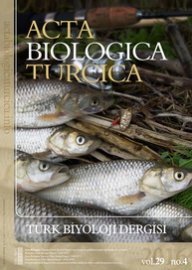A comparative assessment of the Black Sea anchovy stock using holistic production and analytical age structure models
Abstract
Keywords
Full Text:
PDFReferences
AcARA, A. (1960). Preliminary Report on" Pektas Expedition. Inter. Comm. for the Scien. Exp. of the Mediterranean, 16(3), 647-648.
Bingel F., Kideys A.E., Ozsoy E., Tugrul S., Basturk O. and Oguz T. (1993) Stock assessment studies for the Turkish Black Sea coast. NATO-TU Fisheries Final Report. Institute Of Marine Sciences. METU Içel Turkey 108p.
Caddy, J.F., (1992). Rehabilitation of natural resources. Environmental management and protection of the Black Sea Technical Experts Meeting, 20–21 May, Constanta, Romania (1992).
Campbell, D. (1993). Socio-economic study of the Black Sea fisheries. Report of the Second Technical Consultation on Stock Assessment in the Black Sea, Ankara, Turkey, 15–19 February. FAO Fisheries Report, (495).
Castilla-Espino, D., García-del-Hoyo, J. J., Metreveli, M., & Bilashvili, K. (2014). Fishing capacity of the southeastern Black Sea anchovy fishery. Journal of Marine Systems, 135, 160-169.
Chashchin, A. K. (1996). The Black Sea populations of anchovy. Scientia Marina, 60(2), 219-255.
Chashchin, A., Shlyakhov, V. A., Dubovik, V. E., & Negoda, S. (2015). Stock as-sessment of anchovy (Engraulis encrasicolus L.) in Northern Black Sea and Sea of Azov. Progressive Engineering Practices in Marine Resource Man-agement Stock Assessment of Anchovy (Engraulis encrasicolus L.) in Northern Black Sea and Sea of Azov. I. Zlateva, V. Raykov & N. Nikolov (eds) USA: IGI Global, 209-243.
Cooper, A. B. (2006). A guide to fisheries stock assessment: from data to recommen-dations. University of New Hampshire, Sea Grant College Program.
Damalas, D., & Osio, G. C. (2014). Scientific , Technical and Economic Committee for Fisheries ( STECF ) Black Sea assessments. http://doi.org/10.2788/19168
Darby, C.D. and Flatman, S. (1994). Virtual Population Analysis: Version 3.1 (Windows/DOS), User Guide. Inf. Techn. Ser., MAFF Direct. Fish. Res., Lowestoft (1): 85 p.
Daskalov, G. (1998). Using abundance indices and fishing effort data to tune catch- at-age analyses of Sprattus sprattus L., Merlangius merlangus and Squalus acanthías L. in the Black Sea, 228, 215–228.
Gislason, H., Daan, N., Rice, J. C., & Pope, J. G. (2010). Size, growth, temperature and the natural mortality of marine fish. Fish and Fisheries, 11(2), 149-158.
Gucu, A.C. (1997). Role of fishing in the Black Sea ecosystem. In: Sensitivity to Change: Black Sea, Baltic Sea and North Sea (Ozsoy, E., Mikaelyan, A., eds.), Kluwer Academic Publishers, The Netherlands, 149-162.
Gucu, A.C. (2002). Can overfishing be responsible for the successful establishment of Mneiopsis leidyi in the Black Sea? Estuarine, Coastal and Shelf Science, 54, 439-451.
Ivanov, L. and Beverton, R. J. H. (1985) The fisheries resources of the Mediterrane-an. Part two: The Black Sea. Studies and Reviews, GFCM, FAO No. 60:135.
Kideys, A.E. (1994). Recent dramatic changes in the Black Sea ecosystem: The rea-son for the sharp decrease in Turkish anchovy fisheries. J. Mar. Sys., 5, 171- 181.
Mee, L. D., Friedrich, J., & Gomoiu, M. T. (2005). Restoring the Black Sea in times of uncertainty. Oceanography, Vol. 18, No. 2, 32-43.
Patterson, K. (1992). Fisheries for small pelagic species: an empirical approach to management targets. Reviews in fish biology and fisheries, 2(4), 321-338.
Pauly, D. (1980). On the interrelationships between natural mortality, growth parame-ters, and mean environmental temperature in 175 fish stocks. Journal du Conseil, 39(2), 175-192.
Prodanov, K. (1997). Environmental management of fish resources in the Black Sea and their rational exploitation (Vol. 68). Food & Agriculture Org.
Prodanov, K. B., and Stoyanova, M. D. (2001). Stock assessments of the Black Sea anchovy during the period 1979-1993. Mediterranean Marine Science, 2(2), 7-15.
Prager, M. H., & Consulting, P. (2014). User’s Guide for ASPIC Suite , version 7 : A Stock–Production Model Incorporating Covariates and auxiliary programs.
Sampson, D., Charef, A., & Osio, C. (2013). Report 2013 Assessment of Black Sea stocks ( STECF 13-20 ). http://doi.org/ 10.2788/34535
Shepherd, J. G. (1999). Extended survivors analysis: An improved method for the analysis of catch-at-age data and abundance indices. ICES Journal of Marine Science, 56(5), 584-591.
Scientific, Technical, and Economic Committee for Fisheries (STECF)- 2011.Opinion by written procedure: assessment of Black Sea stocks (STECF-OWP-11-06)[G.Daskalov, H.-J. Rat zeds]:216p.
Scientific, Technical, and Economic Committee for Fisheries (STECF)- 2012. Assessment of Black Sea Stocks (STECF-12-15).2012. Publications Office of the European Union, Luxembourg, EUR 25580 EN, JRC 76532,279p.
Scientific, Technical, and Economic Committee for Fisheries (STECF) – 2013 Assessment of Black Sea stocks (STECF 13-20). 2013. Publications Office of the European Union, Luxembourg, EUR 25309 EN, JRC 85367, 429 pp.
Scientific, Technical and Economic Committee for Fisheries (STECF) – Black Sea Assessments (STECF-14-14). 2014. Publications Office of the European Union, Luxembourg, EUR 26896 EN, JRC 92436, 421 pp
Zaitsev, Y. P. (1992). Recent changes in the trophic structure of the Black Sea. Fisheries Oceanography, 1(2), 180-189.
Refbacks
- There are currently no refbacks.

